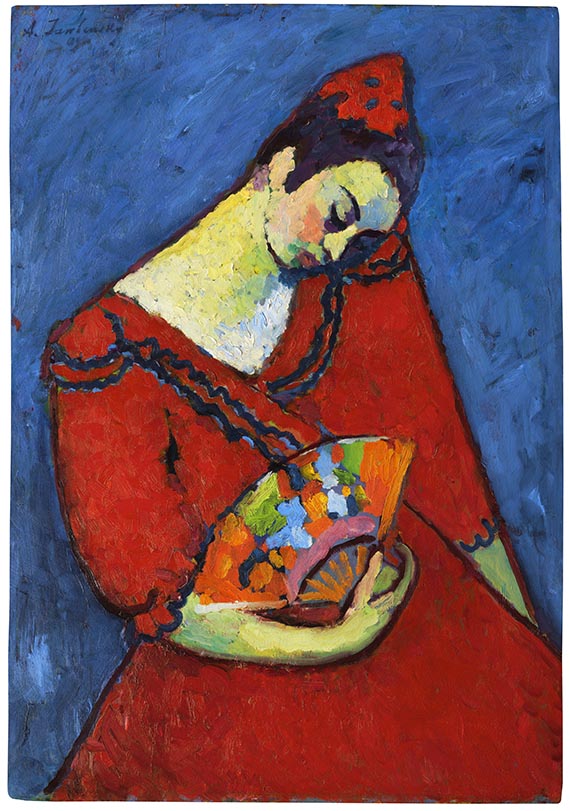Dictionary


'Brücke' group in Dangast
The small town of Dangast on the North Sea coast is closely connected with the development of German Expressionism. It was in spring of 1907 that Erich Heckel and Karl Schmidt-Rottluff first got together in this small town on the Jade estuary, where they, similar to the previous generation of plein air painters, gathered in order to paint in front of nature. The artists' group "Die Brücke", to which both belonged, had not really unfolded its broad effect by this time.
Dangast, a completely unknown place, had not had any tradition as a painters' village at all and seems to have been coincidentally made the summer residence. It was up until 1910 that Erich Heckel and Karl Schmidt-Rottluff regularly spent the warm months of the year in Dangast, which they had meanwhile declared their permanent residence. They were the only "Brücke" painters in Dangast, except for Max Pechstein, who came for a few weeks in summer 1910, Ernst Ludwig Kirchner and Otto Mueller never came to the North Sea.
Erich Heckel and Karl Schmidt-Rottluff, however, created the lion's share of their paintings in Dangast up until 1910. Numerous graphic works were also made there, even though the long way to the nearest printer in Oldenburg made the production more difficult. Very few nudes were made in Dangast - as there simply were less models than in Dresden, which is why they made more portraits, self portraits, still lifes and mostly landscapes.
When observing the Dangast works, it becomes obvious how Expressionism had developed from Impressionism and the direct contact with nature: the forms gradually became harder and more consolidate up to 1910, when the harsh and lurid expressionist style had been fully developed. The importance of the direct contact with nature for the development of the "Brücke" expressionism shows in the Dangast summer stays, but also in the stays on the Moritzburg Lakes near Dresden, on the island of Fehmarn, in Nidden or in Norway, where Karl Schmidt-Rottluff was living for several months in 1911.
Emma Ritter from Oldenburg joined the Dangast artists in 1909, implementing the expressionist style in her paintings in a stunning manner. Also Jan Oeltjen from Jaderberg would soon be in close connection with the expressionist Dangast painters.
In 1922 the artists were honored with a first exhibition in which the "Magic Realist" Franz Radziwill, who had lived in Dangast for some time, also participated.
The small town of Dangast on the North Sea coast is closely connected with the development of German Expressionism. It was in spring of 1907 that Erich Heckel and Karl Schmidt-Rottluff first got together in this small town on the Jade estuary, where they, similar to the previous generation of plein air painters, gathered in order to paint in front of nature. The artists' group "Die Brücke", to which both belonged, had not really unfolded its broad effect by this time.
Dangast, a completely unknown place, had not had any tradition as a painters' village at all and seems to have been coincidentally made the summer residence. It was up until 1910 that Erich Heckel and Karl Schmidt-Rottluff regularly spent the warm months of the year in Dangast, which they had meanwhile declared their permanent residence. They were the only "Brücke" painters in Dangast, except for Max Pechstein, who came for a few weeks in summer 1910, Ernst Ludwig Kirchner and Otto Mueller never came to the North Sea.
Erich Heckel and Karl Schmidt-Rottluff, however, created the lion's share of their paintings in Dangast up until 1910. Numerous graphic works were also made there, even though the long way to the nearest printer in Oldenburg made the production more difficult. Very few nudes were made in Dangast - as there simply were less models than in Dresden, which is why they made more portraits, self portraits, still lifes and mostly landscapes.
When observing the Dangast works, it becomes obvious how Expressionism had developed from Impressionism and the direct contact with nature: the forms gradually became harder and more consolidate up to 1910, when the harsh and lurid expressionist style had been fully developed. The importance of the direct contact with nature for the development of the "Brücke" expressionism shows in the Dangast summer stays, but also in the stays on the Moritzburg Lakes near Dresden, on the island of Fehmarn, in Nidden or in Norway, where Karl Schmidt-Rottluff was living for several months in 1911.
Emma Ritter from Oldenburg joined the Dangast artists in 1909, implementing the expressionist style in her paintings in a stunning manner. Also Jan Oeltjen from Jaderberg would soon be in close connection with the expressionist Dangast painters.
In 1922 the artists were honored with a first exhibition in which the "Magic Realist" Franz Radziwill, who had lived in Dangast for some time, also participated.
Offers
Headquarters
Joseph-Wild-Str. 18
81829 Munich
Phone: +49 89 55 244-0
Fax: +49 89 55 244-177
info@kettererkunst.de
Louisa von Saucken / Undine Schleifer
Holstenwall 5
20355 Hamburg
Phone: +49 40 37 49 61-0
Fax: +49 40 37 49 61-66
infohamburg@kettererkunst.de
Dr. Simone Wiechers / Nane Schlage
Fasanenstr. 70
10719 Berlin
Phone: +49 30 88 67 53-63
Fax: +49 30 88 67 56-43
infoberlin@kettererkunst.de
Cordula Lichtenberg
Gertrudenstraße 24-28
50667 Cologne
Phone: +49 221 510 908-15
infokoeln@kettererkunst.de
Hessen
Rhineland-Palatinate
Miriam Heß
Phone: +49 62 21 58 80-038
Fax: +49 62 21 58 80-595
infoheidelberg@kettererkunst.de
We will inform you in time.




